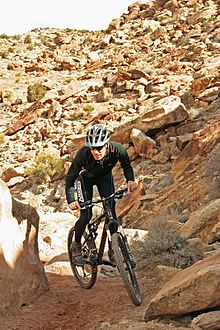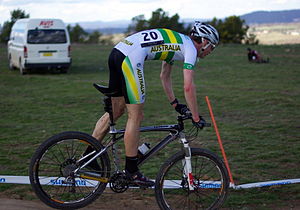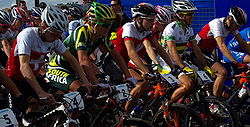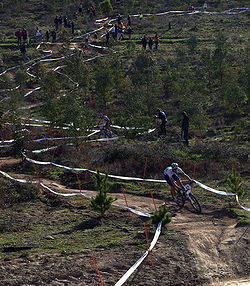- Cross-country cycling
-
 A cross-country mountain biker on a trail in Utah.
A cross-country mountain biker on a trail in Utah.
Cross-country (XC) cycling is the most common discipline of mountain biking. While less publicized than downhill cycling as it is more difficult to televise, it garners the highest levels of participation both recreationally and competitively.[citation needed] . Cross-country cycling became an Olympic sport in 1996 and is the only form of mountain biking practiced at the Summer Olympics.[1]
Contents
Terrain
Cross-country cycling is defined by the terrain on which it is performed. XC courses and trails consist of a mix of rough forest paths and singletrack (also referred to as doubletrack depending on width), smooth fireroads, and even paved paths connecting other trails. Riding or racing is also only deemed cross-country if the technical complexity of the trails is easy or moderate. Trails nearly impossible even to experienced riders are more often dubbed "all-mountain", "freeride", or "downhill".
Bikes and equipment
Further information: Mountain bikeBicycle helmets are often used for cross-country riding.[2] However, XC riders only rarely wear full-face helmets and do not wear the full body "armour" employed by downhill riders. Cross country cyclists are more prone to injuries than road cyclists; however, the injuries sustained by XC riders are usually not as severe.[3]
Cross-country bicycles are some of the lightest mountain bikes, typically between 7-16 kilos (15 and 30 lbs). They usually feature suspension forks in front and sometimes have suspension in the rear. In both the front and rear, most XC bicycles have approximately 100 millimeters (4 inches) of suspension travel, though some riders prefer 125-150 millimeters (5 to 6 inches) of travel as bicycle frame strength and technology advance. The geometry of the frames generally place the rider in a little more upright position than on a road bicycle but incomparably less so than on a downhill bike.
Racing
Cross-country racing emphasizes endurance above technical prowess, and races vary from 30 minutes to 24 hours in length. Additionally, many mountain bike races are divided up into stages so as to span several days. Races can be either point-to-point or lap-based. Short-track cross-country consists of many very short laps so as to be spectator-friendly.
Unlike downhill races, which are conducted in a time trial format, cross-country races traditionally feature a mass start or interval start, where riders are released in several large groups divided by age and/or ability. Races with very large fields that do not wish to stagger starts will sometimes employ a Le Mans start where racers begin by running to their bikes.
Globally, XC racing is governed by the Union Cycliste Internationale. In the United States, it is under the purview of USACMTB a division of USA Cycling. In the United Kingdom, British Cycling is the governing body.
Wheel Size
In cross-country, more than other areas of mountain biking, a debate has begun over the optimal wheel size. The currently used 26 inch wheel size was settled on with the inception of the current age of mountain biking, but there are two other options currently being used: 650b and 29". 650b wheels are 584 mm diameter wheels, and approximately 27.5" with a mounted tire. 29" wheels are basically wider equivalents of the road-going 700c format, being 29" with mounted tires.
650b bikes are still rather rare, while 29" bikes, or "29ers" are rapidly gaining in popularity, and having some success in cross-country racing. A notable boost to their popularity has been 7 time Tour de France winner Lance Armstrong racing and winning on a Gary Fisher 29er[4]. Advantages to the larger wheel formats are better traction due to a larger tire footprint, less need for suspension due to a decreased angle of attack, less loss of momentum and lower rolling resistance. Disadvantages are increased weight, decreased acceleration, rider fit issues for those under 5'5", and slower handling, although handling issues are being addressed successfully in newer designs with geometry changes like steeper head tube angles and higher fork offsets.
See also
References
- ^ http://gorp.away.com/gorp/activity/biking/expert/olympic.htm Mountain Biking in the Olympics
- ^ Attewell RG, Glase K, McFadden M (May 2001). "Bicycle helmet efficacy: a meta-analysis". Accid Anal Prev 33 (3): 345–52. doi:10.1016/S0001-4575(00)00048-8. PMID 11235796. http://linkinghub.elsevier.com/retrieve/pii/S0001-4575(00)00048-8.
- ^ Chow TK, Bracker MD, Patrick K (August 1993). "Acute injuries from mountain biking". West. J. Med. 159 (2): 145–8. PMC 1022220. PMID 8212679. http://www.pubmedcentral.nih.gov/articlerender.fcgi?tool=pmcentrez&artid=1022220.
- ^ http://quickstopbike.blogspot.com/2008/12/lance-armstrong-winning-on-gary-fisher.html
External links
- International Cycling Union (Union Cycliste Internationale)
- International Mountain Bicycling Association
Mountain bike racing Practices Cross-country · Downhill · Freeride · Dual slalom · Four-cross · Marathon · Mountain bike orienteering · 24 hour · TrialsEvents Categories:- Mountain biking
- Endurance sports
Wikimedia Foundation. 2010.





